Ijraset Journal For Research in Applied Science and Engineering Technology
- Home / Ijraset
- On This Page
- Abstract
- Introduction
- Conclusion
- References
- Copyright
Day Ahead Solar Generation Forecasting in Smart Grids to Minimize Electricity Bill
Authors: Sagi Sai Krishna , Dr. Ram Krishan
DOI Link: https://doi.org/10.22214/ijraset.2023.55780
Certificate: View Certificate
Abstract
In order to meet the increasing growth of energy demand, integration of renewable resources into residential applications appears to be a viable solution. In the proposed model, a residential house is considered where the consumer is able to generate his own energy from a microgrid consisting of solar panels and wind turbines. In this study, an optimization method is employed to minimize the overall electricity bill of a residential home over a period of 24 hours. In smart grids, energy management is imperative in reducing the electricity cost of consumers under a real time pricing approach. Nowadays, learning-based modeling methods are utilized to build a precise forecast model for renewable power sources. In this paper, we propose a long short-term memory (LSTM) recurrent neural network-based framework, which is one of the most popular techniques of deep learning. This technique predicts day ahead solar irradiation and wind speed data. We also consider an energy storage system (ESS) for efficient energy utilization. Optimization is done and from the obtained results a substantia l reduction in electricity bill is observed.
Introduction
I. INTRODUCTION
A. Background
Energy and environmental issues are two key roadblocks in the pursuit of global sustainable development. In most nations, power supply still mainly relies on the combustion of traditional fossil fuels which has brought serious environmental problems. At the same time, electricity consumption has increased significantly with the explosive growth of population and the rapid development of the economy, especially for residential electricity consumption. Renewable energy generation is the more sustainable alternative for sustaining the energy demands of our society. alternative energy and wind energy are both unlimited in supply and eco-friendly when utilized for energy generation. In a trial to cut back the nationwide carbon footp1rint, they played a considerable role in energy generation in recent years, with governments worldwide installing said units individually and collectively.
Smart grids are power grids with advanced communication and control technologies between consumers and generating stations, delivering optimized power usage, clean energy at reduced cost, and improving the standard of energy and efficiency of the facility grid. With microgrids, evolution dependence on fossil fuels is reduced, and the excess carbon emission problem is resolve d. Furthermore, the microgrid relates to smart homes in modes like grid-connected and islanded. In island mode, microgrids and commercial grids couldn't initiate the purchase/sell mechanism of energy. On the opposite hand, in grid-connected mode, the microgrid purchases and sells electricity from/to the external grid. The microgrid includes renewable energy sources (RES) like solar, wind to come up with electricity, contributing to electricity bill minimization. Furthermore, RES are intermittent in nature; thus, one cannot depend on them. Therefore, ESSs (Energy storage system) are used with RES to unravel this problem.
In the recent past, a major form of forecasts has been employed. The choice of a forecasting model is usually dependent on the available data , the model network mechanism’s aims, and also the energy planning operation. Throughout this paper, we examine renewable energy and power forecast models used as an energy planning tool. Machine learning mode ls handle enormous data while also providing precise predictive analyses. By integrating various models, we may improve forecasting accuracy. Machine learning models, when utilized correctly, can help one make the better decision because they will extract and model previously unknown correlations and characteristics. Machine learning subtypes, like Artificial Neural Networks (ANNs), operate by extracting high dimensional complex nonlinear features to map input and output variables. Deep learning subtypes, like Long Short Term Memory (LSTM), operate by solving complex problems with multiple layers of knowledge. Despite their differences, they’re both capable of predicting the information. during this paper, forecasting is finished using LSTM for more accurate results.
The main issue to be catered within smart grid/smart house is energy management, whose main purpose is to provide good control to the user over the power usage to push the efficient use of electricity, which is done with the implementation of demand response (DR). The DR is classed in 2 classes, namely: direct DR program, in this the electrical utility company (EUC) operator interrupts or disconnects the load as per the contract signed with the consumer; indirect DR program, in this user changes/adapts their demand in response to the offered pricing signaled by the EUC operator. The second DR program is the ma in focus of this work. The indirect DR program plays an important role in reliable and cost efficient, installation operations. The price can be reduced using scheduling smart home appliances using an indirect DR program.
B. Objectives
- Develop the optima l artificial intelligence (AI) model for the short-term forecasting of solar irradiance.
- Apply the predicted values of PV power and Wind power output for load scheduling and battery operations.
- Minimize the electricity bill.
C. Summary
Taking all these factors into consideration this work proposes an optimized management scheduling method to user activities by considering RTP prices with the main aim to minimize the user’s electricity bill. In addition, we investigate a smart home connected to microgrid equipped with PV panels and WT connected to the power grid. We also use static storage (ESSs) to take care for uncertainties in the generated power from RES’s and ensure the reliable management of electricity. Moreover, a LSTM prediction model is developed and is used to predict day ahead solar irradiance and wind speed for accurate. prediction. Results show that the newly developed model based on the LSTM technique is accurate and effective, which also considerably reduces the user’s electricity bill.
D. Outline of the report
IN SECTION 2: We discussed about the literature survey done
IN SECTION 3: We explained the methodology used in this report
IN SECTION 4: Results are explained, and the related discussions are presented IN SECTION 5: The report is concluded.
II. LITERATURE REVIEW
A. Previous Research
M.F. Khan et al. [1] led a reenactment based study to evaluate the variety of inverter yield with the variety of sun powered light. A relationship was found between inverter yield and sun powered irradiance, with a major expansion in inverter yield in late spring months like July contrasted with cold weather months like December. Cloud-prompted change in sun based irradiance, it likewise changes the PV yield. At long last, we've to discover that when irradiance diminishes radically, the change detaches the heap from the inverter yield.
Shakya et al. [2] conducted a trade sun oriented irradiance gauging technique for remote microgrids upheld the Markov Exchanging Model (MSM), by involving locally accessible information to conjecture sunlight-based irradiance for the next day. this is frequently done to plan energy assets in remote microgrids by utilizing past sun oriented irradiance information, Clear Sky Irradiance (CSI), and Fourier premise developments to shape straight models for 3 systems or states: high, medium, and low energy systems for a really long time identical to radiant, somewhat overcast, and exceptionally shady days, separately. Other than collected private burden during an enormous scope, determining an electrical heap of one energy client is reasonably provoking thanks to the high instability and vulnerability included.
To limit the transmission and appropriation misfortunes inside the influence network, power plants are require d that are nearby utilization regions. This alludes to the greener energy sources like a microgrid. Whenever a most extreme piece of power utilization is created from the microgrid, the high fossil fuel byproduct issue is consequently tackled, where roughly, 41% carbon impression is radiated by the energy area and transport area produces 23% of all out ozone harming substances all over the planet.
To handle this issue, Sheraz Aslam et al. [3] proposed a home energy the board plan to relieve the energy cost of the private family, expanding upon a reasonable home with a few savvy machines. The shrewd house is additionally incorporated with a matrix associated microgrid that is engaged by RESs. A verifiable information-based EDE-ANN model was created for exact day-ahead energy forecast.
S.Q. Ali et al. [4] planned a heap booking issue as a combinatorial advancement issue obliged by the most extreme interest (MD) limit on a microgrid. This paper zeroed in on the cost based request reaction (PBDR) plans with a two section duty upheld when of Purpose Valuing (ToUP) calculation. Such duties might be utilized as an instrument by the utilities to spur the customers to move their heaps to low-cost periods a large number of days.
Rocha et al. [5] nitty gritty a roundabout interest reaction (DR) program concentrate on that would help clients in decreasing expenses and further developing their solace level by planning shrewd home apparatuses. "Essentially, the DR program is utilized to plan various homes' heaps with the indistinguishable residing designs in Kim et al. [6]. Be that as it may, the suspicions made by the creators appear to be unreasonable in light of the fact that, typically, numerous homes don't have the indistinguishable gadgets with the indistinguishable activity time and power rating. A totally remarkable energy the executives plan can make an ideal timetable of apparatuses power use, which represents the indistinguishable profile on the grounds that the power created by a microgrid." The clients lessen power cost and import a second measure of energy from the business establishment by embracing the ideal timetable. In that capacity, energy the executives is integral to dependable microgrid activity.
D. Hadjout et al. [7] fostered a totally exceptional gathering calculation upheld profound figuring out how to accomplish exceptionally exact long-medium-term power utilization determining. Three particular AI models - LSTM, GRU and TCN - were joined to be informed the development of power consumption.[8] The n, the creators utilized a weighting technique to get a definitive weight incorporation. to see the ideal weight coefficients of each and every model, a GS system is utilized. In this way, a definitive power utilization gauging results are accomplished by the total of three anticipating consequences of different profound learning models with the idea l weight coefficients got by the GS calculation.
Aslam et al. [9] proposed an effective energy the board strategy to methodically deal with the energy utilization inside the domain to reduce the level to average proportion and moderate power cost along with client solace boost. We fostered an effective energy the executives plot utilizing blended number applied arithmetic (MILP), which timetables shrewd machines and charging/releasing of electrical vehicles (EVs) ideally to relieve energy costs. To confirm and approve the significant time ways of behaving of the model, advancement results are contrasted, and the power levies and an extensive expense decrease is noticed.
Doroudchi et al. [10] applied Blended Whole number Direct Programming (MILP) to improve the energy cost of a solitary family house with battery energy capacity for four unique situations of introducing sun powered chargers. A network associated homegrown PV framework with battery capacity reinforcement (PV/stockpiling framework) framework, which essentially affects diminishing energy costs and adds to meet the necessities of an almost net-zero energy building., was utilized. The mathematical outcomes demonstrated that it is for sure practical to coordinate capacity frameworks in network associated PV frameworks in private applications, other than showing the effect of battery size on month-to-month energy cost.
Gopinath et al. [11] looked into the specialized appraisal strategies for a framework associated sunlight based photovoltaic (PV) — battery capacity framework — concerning most extreme interest shaving. The reasoning lies in that a successful battery stockpiling framework can give the additional energy required during the pinnacle energy utilization periods, as well as when sustainable power (RE) sources go disconnected. The survey demonstrated that greatest interest shaving with great Return-of-Venture (return for capital invested) can be accomplished by considering the genuine burden profile, specialized, and financial parts of the sun-oriented PV-battery framework.

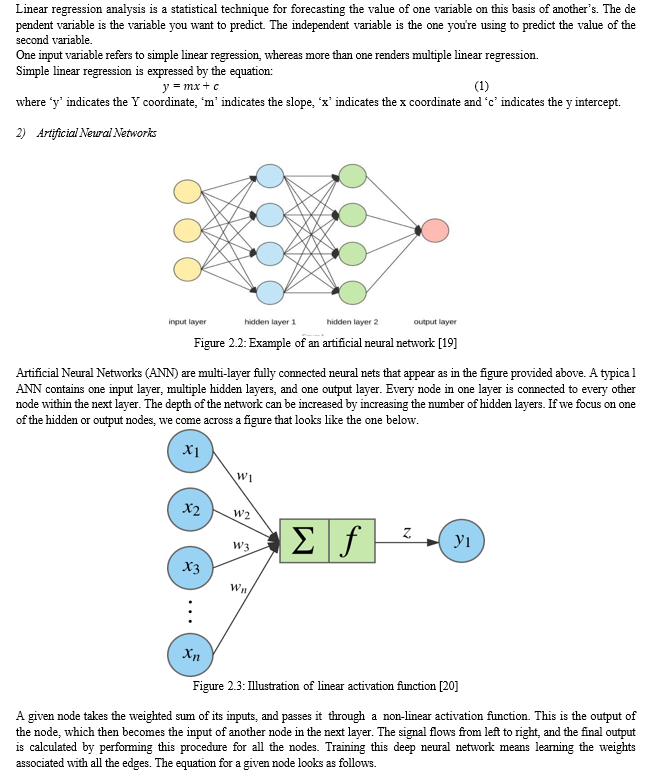

In the above chart, a piece of brain organization, A, sees some info xt and results a worth ht. A circ le permits data to be passed starting with one stage of the organization then onto the next.
These circles cause repetitive brain organizations to appear to be somewhat secretive. In any case, assuming you think a touch more, incidentally, they aren't exactly unique in relation to an ordinary brain organization. An intermittent brain organization can be considered numerous duplicates of a similar organization, each passing a message to a replacement. Think about what occurs on the off chance that we unroll the circle, additionally given in Figure 2.4. This cha in-like nature uncovers that intermittent brain networks are personally connected with successions and records. They're the normal engineering for brain organizations to use for such information.
4) The Problem Of Long Term Dependencies
One of the allures of RNNs is the possibility that they could possibly associate past data to the current undertaking, for example, utilizing past video casings could illuminate the comprehension regarding the current edge. On the off chance that RNNs could do this, they'd be incredibly helpful. Yet, they aren't generally ready.
Once in a while, we just have to take a gander at ongoing data to play out the current errand. In such cases, where the hole between the pertinent data and the spot that it's required is little, RNNs can figure out how to utilize the previous data. Be that as it may, there are additionally situations where we want additional background info. It's not difficult to imagine for the hole between the important data and where turning out to be exceptionally large is required. Sadly, as that hole develops, RNNs become incapable to figure out how to interface the data.
Hypothetically, RNNs are totally e quipped for dealing with such "long haul conditions." Basically, notwithstanding, RNNs don't appear to be ready to learn them. The issue was investigated inside and out by Hochreiter [12] and Bengio, et al. [13], who revealed pragmatic troubles have been accounted for in preparing intermittent brain organizations to perform assignments in which the fleeting possibilities present in the info/yield groupings range long stretches. Luckily, LSTM beats this obstacle.
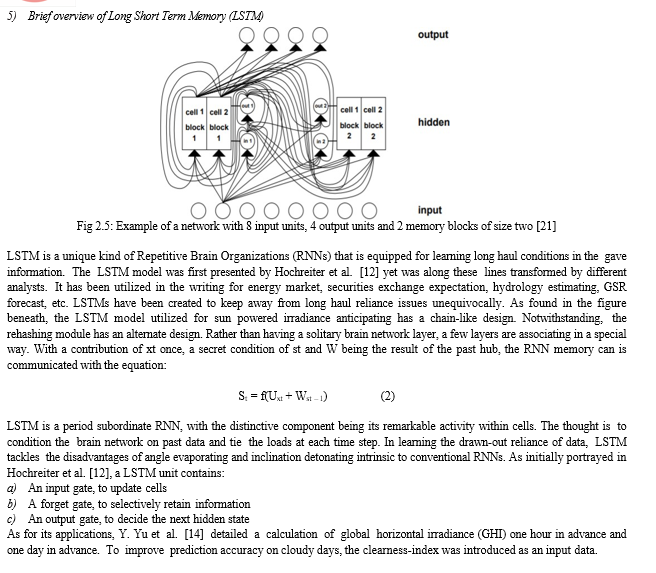
C. Identifying The Optimal Model For The Project
S. Gbémou et al. [15] led a relative investigation of AI techniques for GHI estimating, using two years of information with a period step of 10 minutes to prepare the models and gauge GHI at different time skylines. The three measures utilized for execution assessment were: standardized root mean square mistake (nRMSE), dynamic mean outright blunder (DMAE) and inclusion width-based rule (CWC). While taking a gander at the nRMSE upsides of the AI models for all skylines, the LSTM model outflanked the others as the gauge skyline expanded. A comparable pattern of more prominent precision on account of LSTM models was noticed for the other two basis (CWC and DMAE), particularly during overcast days. This can be credited to the innate capacity of LSTM models in recognizing long haul conditions in information.
W. Kong et al. [16] nitty gritty a long transient memory (LSTM) intermittent brain network-based system, which is the most recent and one of the most famous methods of profound learning, to handle this interesting issue. "Numerous benchmarks are extensively tried and contrasted with the proposed LSTM load gauging structure on a genuine world dataset. Incidentally, many burden estimating approaches which are effective for matrix or substation load gauging battle in the single-meter load determining issues. The proposed LSTM system accomplishes commonly the best determining execution in the dataset.
Additionally, albeit individual burden anticipating is nowhere near exact", conglomerating all singular figures yields better gauge for the total le vel, contrasted with the regular procedure of straightforwardly estimating the amassed loa d.
In February of the year, López et al. [17] fostered a forecaster to anticipate sun-oriented light in the extremely present moment (10 min ahead). Two instruments were created in light of ANNs, in particular LSTM and CNN. The instrument was tried with root mean square mistake as the measuring stick and brought about an improvement of 8.16%
Moreover, for the 82% of the tried days it has given an under 4% mistake between the anticipated and the real energy age. All in all, they avowed the suitability of their calculation in the execution of a PV age plan-working on their mix into the electrical lattice for power age.
D. Selection Of Performance Evaluation Criteria
Mean square error is defined as the averaged square difference between model outputs and the target. It is expressed with the equation:
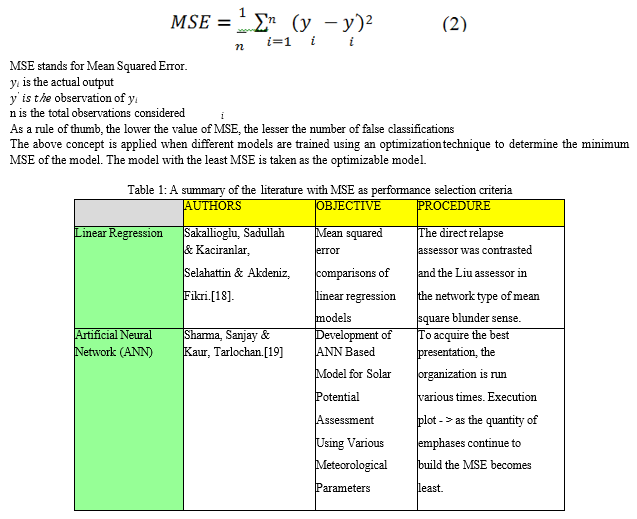
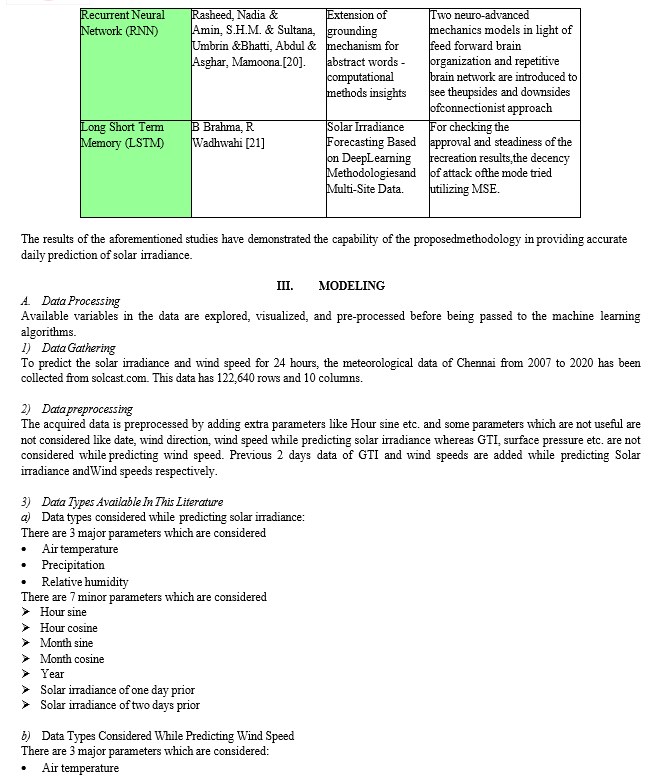





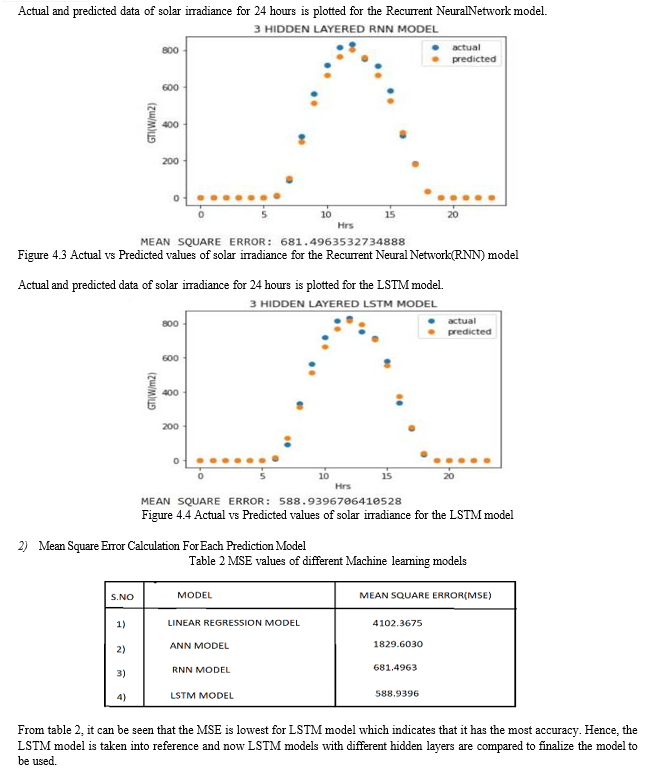
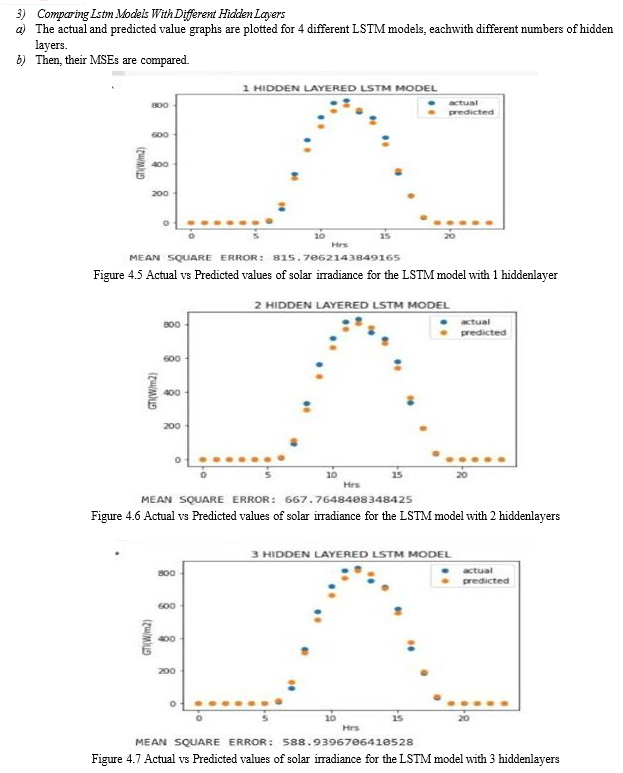

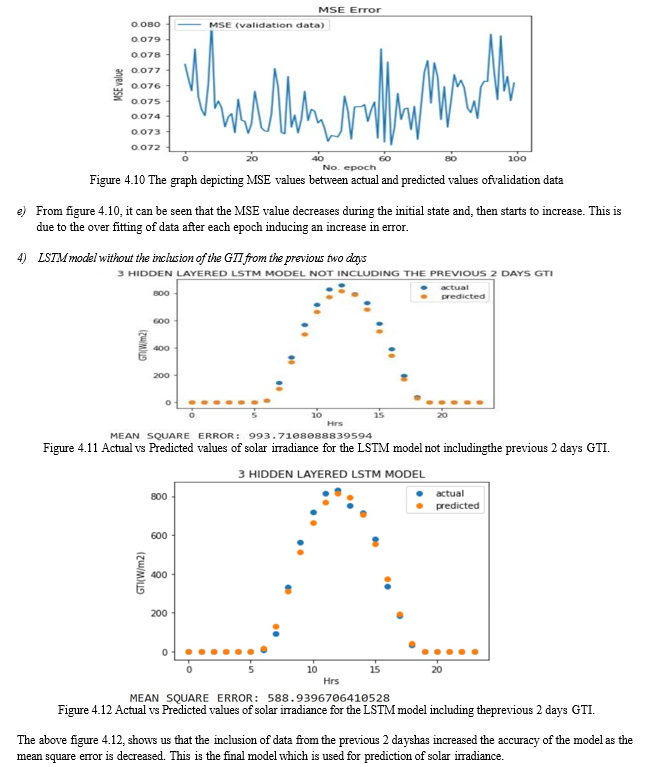
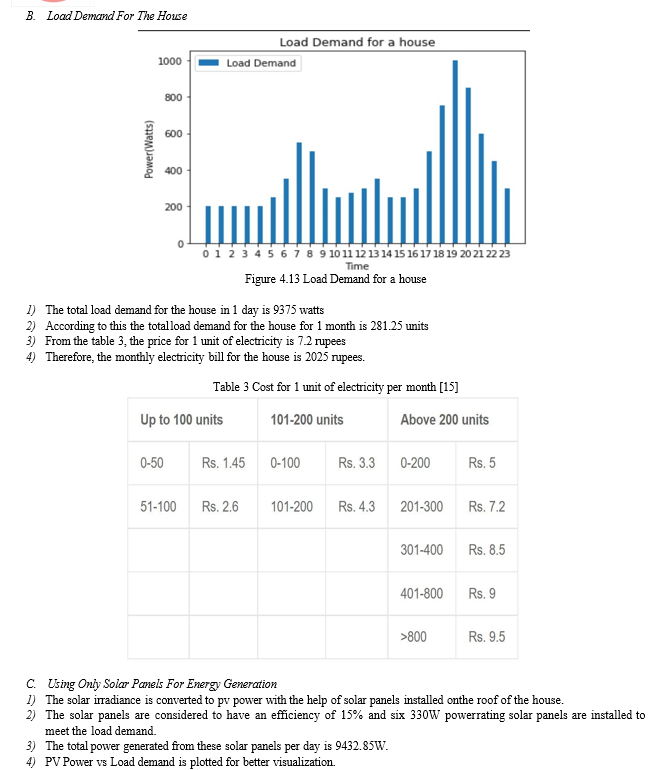
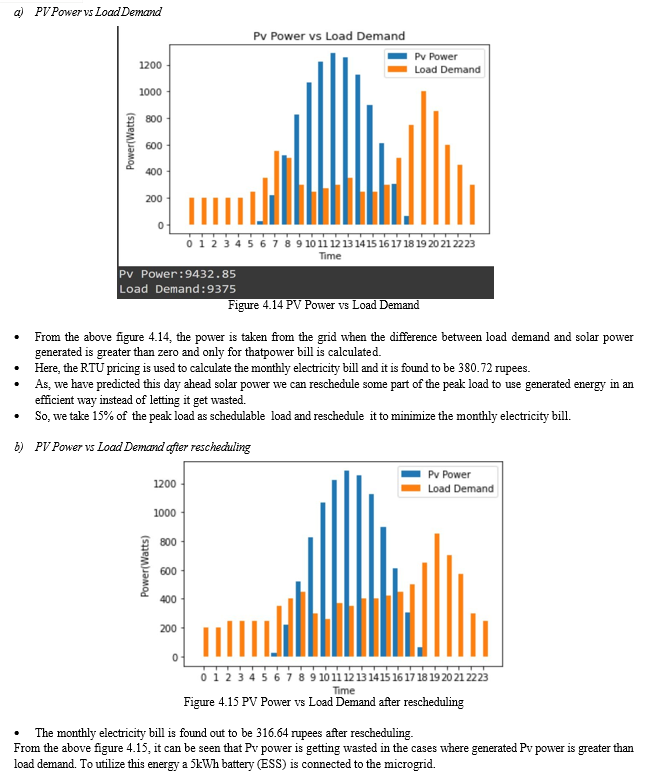
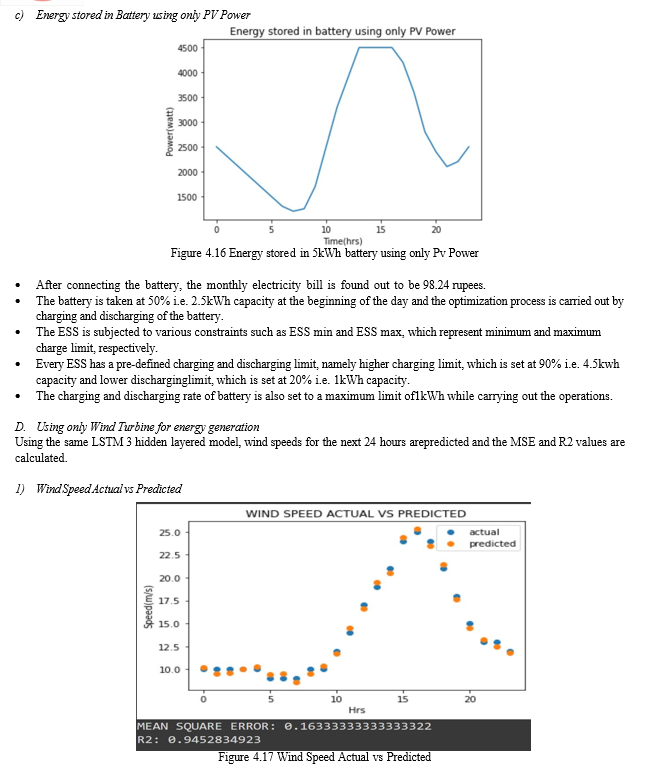
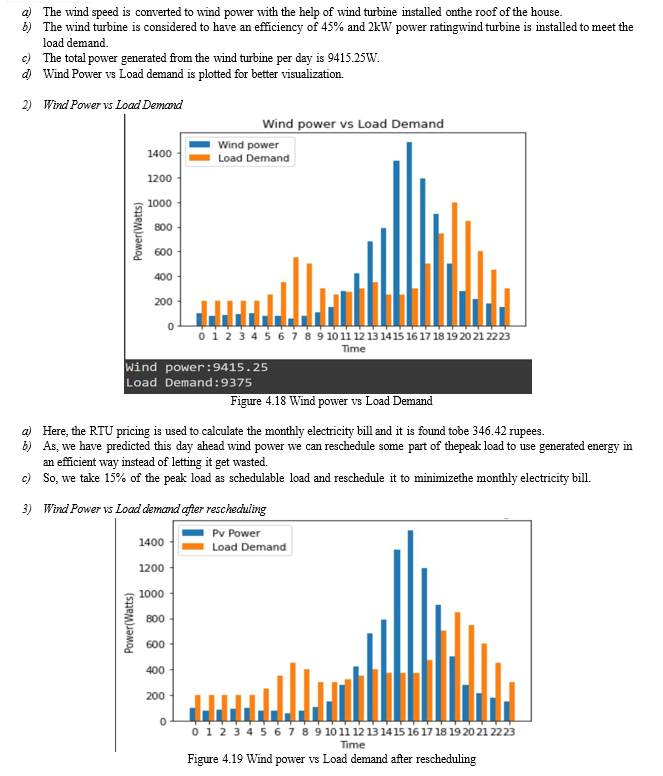
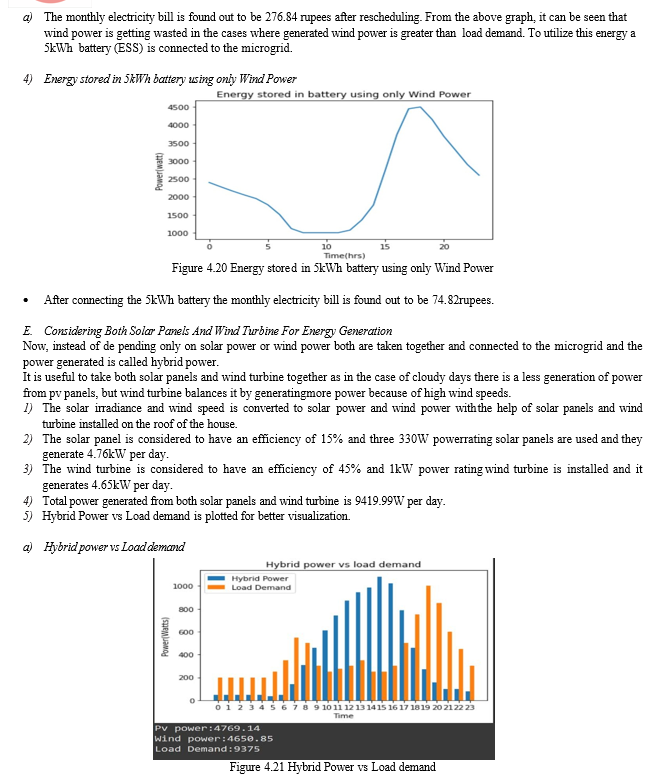

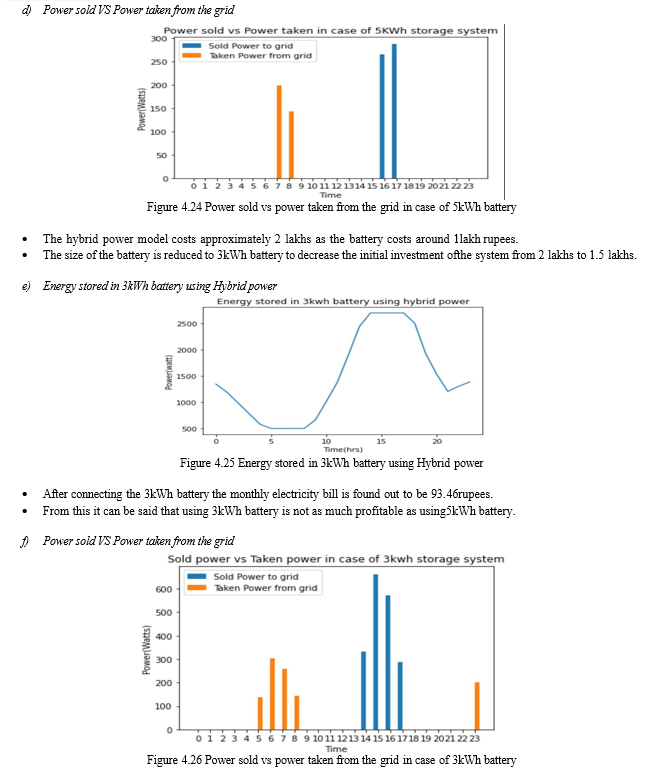
F. Time Taken To Pay Back The Initial Investment
- While calculating number of years to return the initial investment the money saved in each month is considered as payment.
- Also, the Indian government provides a subsidy of 30% for installation of any RES in households. So the initial investment becomes 1,40,000 rupees.
- The rate of interest is taken as 10% and also while calculating the rate of return the load is considered to increase by 10% for every 2 years.
- So, the load becomes 10,312 after 2 years, 11,343 after another 2 years etc.
- The monthly electricity bill also changes as the load changes. The monthly electricity bill becomes 2227.34 rupees after 2 years, 2450.08 after another 2 years etc.
- The monthly electricity bill after integrating the hybrid model is 75. 12 after 2 years, 145.23 rupees after another 2 years etc.
- The monthly payment back by the user is the savings made from using the model so, 2025-15.36 rupees i.e.. 2009.64 rupees per month during the first 2 years, in the same way 2227.34-75. 12 rupees i.e.. 2153.22 rupees per month during the next 2 years etc.
- Finally taking all these factors into consideration, no of years it takes to pay back the initial investment is 6.94 years.
V. ACKNOWLEDGEMENT
We whole heartedly thank our guide Dr. Ram Krishnan, Assistant Professor, Department of Electrical Engineering, for being a constant source of motivation, supervision and encouragement, which in hindsight has proven to be invaluable to this project report.
We are grateful to Dr. Sailaja Kumari, Professor and Head of Electrical Engineering Department, for providing us with all the facilities to carry out this project work. We are immensely thankful to her for her mora l support during the total span of this Project.
We are also very thankful to the Project Evaluation Committee, for their strenuous efforts to evaluate our projects.
We consider it as a great privilege to express our deep gratitude to many respected personalities who guided, inspired and helped us in the successful completion of the project.
We are also thankful to all our friends who have given valuable suggestions and help in all stages of the development of the project.
Finally, we would like to dedicate this work to our parents who have provided support and encouragement during every part of our life.
Onwards and upwards, now and forever.
Conclusion
A. Determination Of Optimal Machine Learning Model LSTM model prediction results were compared against those of the RNN model as well as conventional ML models like ANN and linear regression approaches. B. Determination of optimal LSTM structure 1) To improve the accuracy of the LSTM model, this study examined 4 different LSTM structures, each with a different depth. 2) The three-layer LSTM model was found to be the most accurate and hence is used to predict solar irradiance. C. Determination Of Optimal Input Dataset 1) We also found out that inclusion of previous 2 days data increased the accuracy of the LSTM model. 2) Upon training and arriving at the best model (the LSTM model with 3 hidden layers), it was able to predict day-ahead solar irradiance with a 6% error. 3) The same model is again used to determine the day-ahead wind speed with a error of 7%. D. Determination Of Optimal Microgrid Model 1) The three electricity bills from the microgrid models using three powers: Solar power, Wind power and Hybrid power are compared and it is shown that using the Hybrid model the electricity bill is minimized more. 2) Load rescheduling is also done to minimize the power drawn during peak time. E. Determination Of Optimal Battery Size 1) Two batteries with different capacities i.e. 3kWh and 5kWh are connected to the Hybrid model and it is found that using 5kWh battery is more advantageous during long term. 2) The monthly electricity bill for the house is decreased from 2025 rupees to 15. 36 rupees after connecting hybrid model with a 5kWh battery. 3) So, this model decreases the monthly electricity cost by 99. 24%. F. Determination Of Payback Period 1) The initial investment for the hybrid model is calculated out to be 1,40,000 rupees with a rate of 10% interest per annum. 2) The load is considered to increase with a rate of 10% for every 2 years. 3) So, considering all these factors the number of years taken to return the initial investment is found out to be 6.94 years. G. Future Scope 1) The accuracy of the LSTM model can be further increased if data like cloud cover can be obtained from the weather stations. 2) Further components like EVs, Micro gas turbines etc. can also be integrated into the microgrid. 3) This model can be extended from the range of a single house to a community.
References
[1] M. F. Khan, M. S. Islam and S. Islam, \"Effect of Variation of Solar irradiance on the Inverter Output for a Grid connected PV system,\" 2019 International Conference on Energy and Power Engineering (ICEPE), 2019, pp.1-4, doi:10.1109/CEPE.2019. 8726568. [2] Shakya, Ayush & Michael, Semhar & Saunders, Christopher & Armstrong, Douglas & Pandey, Prakash & Chalise, Santosh & Tonkoski, Reinaldo. (2016). “Solar Irradiance Forecasting in Remote Microgrids Using Markov Switching Model. IEEE Transactions on Sustainable Energy.” PP. 1-1. 10.1109/TSTE.2016.2629974. [3] Khan, Zahoor & Zafar, Ayesha & Javaid, Sakeena & Aslam, Sheraz & Rahim, Muhammad & Javaid, Nadeem. (2019). “Hybrid meta-heuristic optimization based home energy management system in smart grid. Journa l of Ambient Intelligence and Humanized Computing.” 10. 10.1007/s12652-018-01169-y. [4] Ali, Syed Qaseem & Maqbool, S. & Ahamed, Imthias & Malik, N.H.. (2013). “Load scheduling with maximum demand and time of use pricing for microgrids.” 234-238. [5] 10.1109/GHTC-SAS6629922. [6] Rocha, H.R.O.; Honorato, I.H.; Fiorotti, R.; Celeste, W.C.; Silvestre, L.J.; Silva, [7] J.A.L. “An Artificial Intelligence based scheduling algorithm for demand-side energy management in Smart Homes.” Appl. Energy 2021, 282, 116145. [8] Kim, B.-G.; Zhang, Y.; Van Der Schaar, M.; Lee, J.-W.”Dynamic pricing and energy consumption scheduling with reinforcement learning.” IEEE Trans. Smart Grid 2015, 7, 2187–2198. [9] Shirazi, E.; Jadid, S. “Cost reduction and peak shaving through domestic load shifting and DERs.” Energy 2017, 124, 146–159. [10] Hadjout, Dalil & Torres, José & Troncoso, Alicia & Sebaa, Abderrazak & Martínez- [11] Álvarez, Francisco. (2021). “Electricity consumption forecasting based on ensemble deep learning with application to the Algerian market. Energy.” 243. 123060. 10.1016/j.energy.2021. 123060. [12] Khan, Muhammad & Usman, Muhamma d & Shafiq, Zeeshan & Wadud, Zahid & Hafeez, Ghula m & Khan, Imran & Khan, Imran. (2020). “Efficient Energy Optimization Day-Ahead Energy Forecasting in Smart Grid Considering Demand Response and Microgrids.” [13] Doroudchi, Elahe & Pal, Sudip & Lehtonen, Matti & Kyyra, Jorma. (2015). “Optimizing energy cost via battery sizing in residential PV/battery systems.” 1-6. 10.1109/ISGT-Asia.2015. 7387155. [14] S.Gopinath, & Ramachandaramurthy, Vigna K. & Sanjeevikumar, P. & MIHET- POPA, Lucian & Blaabjerg, F. & Guerrero, Josep. (2017). “Grid-Tied Photovoltaic and Battery Storage Systems with Malaysian Electricity Tariff - A Review on Maximum Demand Shaving. Energies.” 10. 1-16. 10.3390/en10111884. [15] Sepp Hochreiter, Jürgen Schmidhuber; “Long Short-Term Memory. Neural Compute” 1997; 9 (8): 1735–1780. doi: https://doi.org/10.1162/neco.1997.9.8.1735 [16] Y. Bengio, P. Simard and P. Frasconi, \"Learning long-term dependencies with [17] gradient descent is difficult,\" in IEEE Transactions on Neural Networks, vol. 5, no. 2, pp. 157-166, March 1994, doi: 10. 1109/72. 279181. [18] Yu, Yunjun & Cao, Junfe i & Zhu, Jianyong. (2019). “An LSTM Short-Term Solar Irradiance Forecasting under Complicated Weather Conditions. IEEE Access.” 7. 1-1. 10.1109/ACCESS.2019. 2946057. [19] Gbemou, Shab & Tolba, Hanany & Thil, Stépha ne & Grie u, Stéphane. (2019).” Global horizontal irradiance forecasting using online sparse Gaussian process regression based on quasiperiodic kernels.” 1-6. 10.1109/EEEIC.2019.8783653. [20] Kong, Weicong & Dong, Z.Y. & Jia, Youwe i & Hill, David & Xu, Yan & Zhang, Yuan. (2017). “Short-Term Residential Load Forecasting based on LSTM Recurrent Neural Network. IEEE Transactions on Smart Grid. PP.” 1-1. 10.1109/TSG.2017.2753802. [21] Etxegarai, Garazi & López, Asier & Aginako, Naiara & Rodríguez, Fermín. (2022). “An analysis of different deep learning neura l networks for intra-hour solar irradiation forecasting to compute solar photovoltaic generators\' energy production. Energy for Sustainable Development.” 68. 1 -17. 10.1016/j.esd.2022.02. 002. [22] Akdeniz, Fikri. (1999). 20) Kaç?ranlar, S. Sakall?o?lu, S, Akdeniz, F. , Styan, G. P. H. and Werner, H. J.(1999) \"A new biased estimator in linear regression and a detailed analysis of the widely-analyzed dataset on Portland cement,\" SANKHYA: The Indian Journal of Statistics, 61 Series B,Pt. 3, 443-459 [23] Sharma , Sanjay & Kaur, Tarlochan. (2019). “Efficient solar radiation estimation using cohesive artificial neural network technique with optimal synaptic weights. Proceedings of the Institution of Mechanical Engineers Part A Journal of Power and Energy.” [24] Rasheed, Nadia & Amin, S.H.M. & Sultana, Umbrin & Bhatti, Abdul & Asghar, Mamoona. (2018). “Extension of grounding mechanism for abstract words: computational methods insights.” Artificial Intelligence Review. 50. 10.1007/s10462- 017-9608-9. [25] Brahma, B.; Wadhvani, R. “Solar Irradiance Forecasting Based on Deep Learning Methodologies and Multi-Site Data. Symmetry” 2020, 12, 1830. https://doi.org/10.3390/sym12111830.
Copyright
Copyright © 2023 Sagi Sai Krishna , Dr. Ram Krishan . This is an open access article distributed under the Creative Commons Attribution License, which permits unrestricted use, distribution, and reproduction in any medium, provided the original work is properly cited.

Download Paper
Paper Id : IJRASET55780
Publish Date : 2023-09-18
ISSN : 2321-9653
Publisher Name : IJRASET
DOI Link : Click Here
 Submit Paper Online
Submit Paper Online

